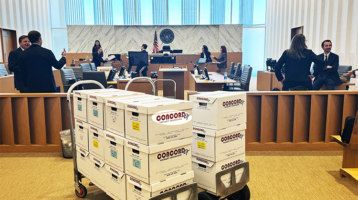E-Discovery Careers: 10 Notable Trends from the 2015 Year in Review
Ask CONCORD about MANAGED SERVICES
(800) 246-7881
While counting down the year-end, take into account of top 10 notable trends in e-discovery for 2015, and what you need to do to survive and thrive in 2016 and beyond.
The year 2015 marks the beginning of a sea change for e-discovery and legal technology staffing and career opportunities. Prospects are bright for ambitious and forward-thinking professionals and increasingly bleak for those comfortable with stagnation and routine. While counting down the year-end, take into account of top 10 notable trends in e-discovery for 2015, and what you need to do to survive and thrive in 2016 and beyond:
1. The Great Roll-Up
With overwhelming consolidation in the service provider space, vertical and financial mobility has shifted away from law firms and corporations and moved to the consultancies and large vendors. There were more jobs than ever before at vendors in 2015, but at fewer actual vendors. The big players are getting much bigger ($100MM+), and the middle market vendors are getting bought. Notable buys this year include Inventus grabbing Unified and Kooby LLP, UBIC’s buy of Evolve, Epiq getting Iris Data Services, DTI absorbing Merrill Inc. and TRU Staffing Partners acquiring The Kennett Group and forming the TRU Cyber division.
2. “Can You Hack It, E-Discovery?”
Dramatic shifts in corporate attention from “processing, hosting, review” to “security and compliance” will reshape the landscape of career pathways with a strong emphasis and demand on cybersecurity skills and experiences. However, making the transition from e-discovery to info sec/cybersecurity will not be easy. Security is a different discipline with dozens of widely accepted certifications that, unlike the e-discovery space, narrowly define an individual’s skill set and qualifications. Many Am Law litigation support managers who are looking to get promoted internally or take on additional responsibility (and compensation) may actually have to go back to school – literally. Also unlike e-discovery, there is a wealth of undergraduate and graduate programs at universities online and on campus across the country for cybersecurity degrees.
3. Reinvention for Leadership and Project Management
There will be no vertical mobility for litigation support managers at the Am Law 200 and very little upward growth for project managers as well. Managers have few, but specific options: hold on to their existing jobs, increase profitability and ride out the role until it is no longer needed; look toward leveraging their personal brand and relationships and make the move to a consultancy or large vendor; or reinvent themselves internally and find ways to add new, more progressive value – specifically in cybersecurity or legal analytics. Corporations did not hire Am Law litigation support managers in-house in 2015. That will not change. Project managers at law firms who only want to work at law firms or corporations will need to accept that a job move may not mean increased compensation as there is a slowly calcifying ceiling of earning potential for in-house PMs.
4. The 150K Ceiling
If you are wondering who makes more than $150K base salary in e-discovery, they are likely, either directly or indirectly, contributing to an organization revenue generation. Yes, legacy in-house managers who have tenured roles are making more, but very few project managers in Am Law in 2015 were hired at base salaries exceeding 150K. Even fewer professionals were hired by vendors at salaries exceeding 150K. Pricing compression and commoditization are driving down pricing and salaries. If you want to make more money in this field, your best bet is to drive business to a vendor.
5. The Dirtiest Five-Letter Word: SALES
Consultants are feeling the increasing downward pressure to be more “sales-focused,” and sales reps are overwhelmed with revenue expectations dictated by stockholder growth demands. Vendors are no longer selling to buyers who simply don’t understand what e-discovery is and are willing to pay whatever to get it done. Instead, vendors are now competing to steal each other’s clients and usurp established relationships with better pricing, technology, service or all of the above. There is no longer an untapped well of business waiting to be drilled and derricked. Sales in e-discovery is now a hand-to-hand combat sport where every punch counts and every blow could lead to your company getting knocked down or, worse, knocked out of the game. With this as the field of play, vendors expect everyone, from operations to formal business development professionals, to be mindful of and actively contributing to the growth of the bottom line if they want to get paid or recognized. Being good at your job just isn’t enough anymore for seasoned talent.
6. Outliers in Analytics
The window for rapid growth and career mobility for the non-cyber-savvy or non-sales-focused professional is clearly going to be in legal analytics (aka TAR/CAR/PC). This area of e-discovery remains a fractured market with few tools being utilized with frequency. Most attorneys are still only utilizing analytics on less than 10 percent of their cases, but by 2025 the reciprocal will be true. The tech-savvy attorney would be well positioned for growth and compensation increase with an understanding of the niche of legal analytics. Additionally, this is the area where vendors (both those currently in e-discovery as well as outliers who will enter the space) have an opportunity to make an impact and steal business. However, the investment as an individual or a company in focusing on analytics may not monetize quickly. Analytics is a long play. Outliers, the likes of Praescient Analytics, K2 Intelligence, Red Owl and more, will bring tools like Palantir to the legal sector to rival Relativity, Axcelerate, and Ringtail, which currently dominate the market on technology-assisted review.
7. My Relativity Is Better Than Yours!
From a technology perspective, Relativity remains king, but there are percolations of industry-disruptive technology on the horizon and in the mix (mentioned above)! The vendor world remains bracketed into two categories: Relativity providers and proprietary tool providers. Those using proprietary tools like Ringtail, DrivenOne, Axcelerate may struggle to compete for clients who simply “want Relativity.” Conversely, they instantly distinguish themselves from all the Relativity providers available. Meanwhile, Relativity providers are fighting over who can develop better custom workflow and applications that work within Relativity in order to sell to their clients that “my Relativity is better” than everyone else’s.
8. Polarization of Law Firm Models
For years law firm litigation support groups have had various structures and ways of deploying services and pricing/savings to their clients. No more. Law firms are moving to one of two variations: fully in-sourced or managed services/SaaS. For firms whose agenda is revenue and cost control, the in-source model makes sense. These are generally the biggest firms, with an elite handful of boutique firms whose investment in in-house lit support is a direct result of their narrow client base. The managed services model now makes sense for most, pushing hosting, processing and production to the vendors. The adoption of managed services has directly led to jobs leaving firms and going to vendors. Firms in this model will still need in-house coordinators and project managers, but they will not need many, if any, analysts. Any analyst working in a firm with a MS model will likely have nuanced programming or data analytics experience involving NLP, Python, Hadoop, C++ or other highly specialized skills.
9. The Contract Life
Supply may have finally matched demand in e-discovery in 2015 resulting in voluminous contract and temporary opportunities as well as available temporary talent in litigation support! This is good news for clients and candidates. For companies, whether firm, vendor or corporation, that want to maintain lean full-time staffing models, there is an active and available (quality) pool of temporary talent who can assist in times of turnover, crisis or surge in litigation activity. For talent who want to see the world, travel to client sites in times of triage or sample working for a variety of clients in order to gain knowledge, perspective and breadth/diversity of relationships, life as an e-discovery contractor is now a viable and lucrative pathway! In 2015, more clients of TRU Staffing Partners engaged in hiring contract talent than in any previous year, up a whopping 25 percent from 2014.
10. Midwest Moves
Geographically, second- and third-tier markets boast more opportunity than ever before. Chicago surpassed Washington, D.C., in 2015 for available e-discovery positions (not counting the government sector). Talent, in a quest to find quality-of-life or work-life balance while staying in e-discovery, has moved to the Midwest market in record numbers in 2015. Firms are also shifting staffing resources to less expensive cost of living (and cost of talent) locations, most notably Littler and Sedgwick, whose lit support groups now reside in Kansas City, and Pillsbury’s which has gone to Tennessee.


